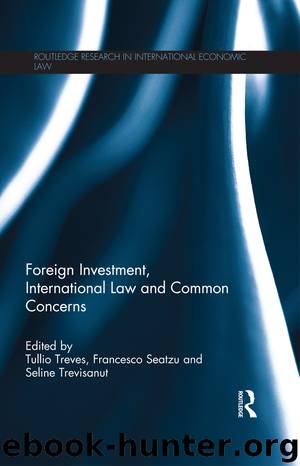Foreign Investment, International Law and Common Concerns by Francesco Seatzu & Seline Trevisanut Tullio Treves

Author:Francesco Seatzu & Seline Trevisanut Tullio Treves [Tullio Treves, Francesco Seatzu and Seline Trevisanut]
Language: eng
Format: epub
Publisher: Routledge
11
Promoting Investments in Sustainable Development Through Multilateral Environmental Agreements
Francesca Romanin Jacur
11.1 Introduction
International cooperation in environmental matters takes place mainly in the framework of complex normative and institutional architectures tackling specific environmental problems: multilateral environmental agreements (MEAs).1 International law and MEAs broadly endorse the concept of sustainable development, generally defined as the ‘development, which meets the needs of the present without compromising the ability of future generations to meet their own needs’.2 Beyond its pleasing definition and wide recognition, little consensus is found however, in theory, on its status as a legal norm and, in practice, on the criteria that activities such as nuclear energy and forestry projects, or carbon capture and storage, and genetic resources exploitation should meet to be considered sustainable.3
The practice of MEAs governing bodies, the Conferences of the Parties (COPs), increasingly reflects the difficulties of reaching consensus on how to combine the ‘interdependent and reinforcing pillars’ of sustainable development, i.e. economic development, poverty reduction and environmental protection.4 Besides these public interest goals, MEAs treaty bodies are now directly involving the private investors as partners to achieve global environmental goals, and consequently need to consider also their economic priorities. ‘In exchange’ for the private actors’ support in transition to more sustainable economies, MEAs offer them new business opportunities, financial and strategic support for the development of new technologies.5
These public–private partnerships (PPPs) in the MEAs context occur mainly in two ways: first, through market-based instruments recently developed under the climate change regime; and second, through MEAs financial mechanisms. Both ways need to be economically attractive to gain the investors’ trust and in the meantime respond to the requirements of sustainability. These private and public interests – even though not necessarily conflicting – need to be prioritized and reconciled one with another.
This recent trend of encouraging private investors’ participation in MEAs’ sustainable development objectives is mainly based on economic considerations. First, since the 1990s it has been repeatedly acknowledged – and the current financial crisis is vehemently confirming – that public financial resources are not sufficient to achieve contemporary sustainable development goals. Second, the use of public funding to catalyze private investment for these purposes produces greater benefits than using public funding directly. Third, the private sector is in a better position to achieve the transformational shift to a more green and sustainable economy, inter alia by developing and transferring new technologies. For these reasons, there is growing attention on innovative finance for sustainable development, which includes mutually reinforcing combinations of public and private resources.6
With these considerations in mind, this chapter first looks at the ways in which private investors participate in MEAs’ (still mainly) interstate investment schemes and financial mechanisms. What are the barriers to private investments? How are MEAs combining their sustainable development mandate with private investors’ necessities?
A second group of issues this chapter examines relates to other ways in which MEAs contribute to shape sustainable investments. Indeed, MEAs, by endorsing rules on impact assessment and public participation in environmental decision-making, strengthen procedural and participatory principles applicable to the investment domain.
Download
This site does not store any files on its server. We only index and link to content provided by other sites. Please contact the content providers to delete copyright contents if any and email us, we'll remove relevant links or contents immediately.
The Brazilian Economy since the Great Financial Crisis of 20072008 by Philip Arestis Carolina Troncoso Baltar & Daniela Magalhães Prates(105880)
International Integration of the Brazilian Economy by Elias C. Grivoyannis(75665)
The Art of Coaching by Elena Aguilar(52210)
Flexible Working by Dale Gemma;(23213)
How to Stop Living Paycheck to Paycheck by Avery Breyer(19570)
The Acquirer's Multiple: How the Billionaire Contrarians of Deep Value Beat the Market by Tobias Carlisle(12115)
Thinking, Fast and Slow by Kahneman Daniel(11804)
The Radium Girls by Kate Moore(11636)
The Art of Thinking Clearly by Rolf Dobelli(9930)
Hit Refresh by Satya Nadella(8866)
The Compound Effect by Darren Hardy(8524)
Atomic Habits: Tiny Changes, Remarkable Results by James Clear(8054)
Tools of Titans by Timothy Ferriss(7828)
Turbulence by E. J. Noyes(7717)
Change Your Questions, Change Your Life by Marilee Adams(7386)
A Court of Wings and Ruin by Sarah J. Maas(7283)
Nudge - Improving Decisions about Health, Wealth, and Happiness by Thaler Sunstein(7261)
How to Be a Bawse: A Guide to Conquering Life by Lilly Singh(7162)
Win Bigly by Scott Adams(6833)
